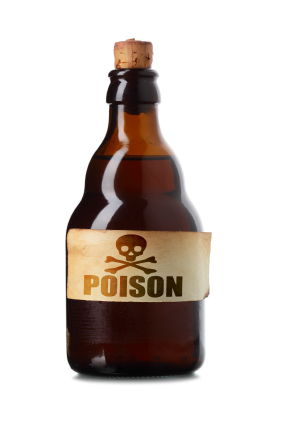 If you eat enough silver, you will turn blue, but it probably won’t kill you.
If you eat enough silver, you will turn blue, but it probably won’t kill you.
In the 1920s, you could buy energy drinks and cosmetics containing radium. Because of its beneficial effects on tumors, it was believed to be healthy.
Arsenic was once known as “the inheritance powder”, because it was so commonly used to eliminate relatives who stayed alive too long.
In the 1930s the poison thallium was used in depilatory creams, because of its excellent ability to make hair fall out, but also because of its ability to lend a beautiful pale luster to the skin.
These are just a few of the fascinating facts and stories you can find in “The Poisoner’s Handbook”, by Deborah Blum. The book came to my attention after I attended a session entitled “Story as Shape or Song” at the recent Science Online conference. In that session, authors Deborah Blum and David Dobbs discussed how geometrical shape and musical compositions can help inform and create structure in nonfiction articles. Deborah Blum presented the idea of stories as shapes ranging from the classic inverted pyramid through arcs, spirals, braids, broken lines and even turtles (story surrounded by bracing evidence). David Dobbs gave an eloquent and beautiful illustration of how musical themes can be applied to the structure of a story in ways that enhance and amplify the storytelling and the message.
Now of course, I have to go away and try to do it in my writing. As always, what seemed so clear at the time of hearing is now proving difficult to put into practice fluently. My attempts at braided narratives are turning out as collections of apparently maniacal random thoughts. So I thought I would take a break and study from a master again. I picked up a copy of “The Poisoner’s Handbook”, and have been reading it in hopes of learning more from Ms. Blum’s example. Subtitled “Murder and the Birth of Forensic Medicine in Jazz Age New York”’ the book is a skillful braiding of various narratives into a compelling history. There is a heavy dose of science sprinkled through the various tales of murder, accident, negligence and politics as the author describes the effect of various poisons and the development of forensic methods to detect them.
Interwoven through the book are the personal stories of New York City’s first medical examiner, Dr. Charles Norris, and forensic toxicologist Dr. Alexander Gettler. Their stories are told against the backdrop of the prohibition era and the various poisoning cases, both deliberate and accidental, that they investigated.
Scientists have some great stories to tell, and this book is an example of science told as a story. The science is all there if you want it, but it is made relevant by the context of the very human stories in which it is presented. I am just over half way through the book and I am finding myself quite saddened by many of these stories. There were the “radium girls” who worked in a factory painting radium-laced, luminescent paint onto the faces of watches, routinely licking their brushes to a fine point to create the delicate lettering. The story of their fight for meager compensation is quite heartbreaking. And then there were the men who went mad from lead exposure after working in a factory producing leaded gasoline, it’s a sobering read. My feelings are summed up by a statement Blum makes in the book:
“Another poison, Another murder, Another story to break your heart”.
Time to Cheer Up
But there is a strong positive note as well. This is mainly a story of how the dedication of two men to the scientific method led to improvements in the detection of poisons, and subsequently improvements in public health. I found it quite shocking that in the 1930s there was no legal requirement to provide lists of ingredients on packaging:
“In 1935 a woman seeking to darken her lashes using Lash Lure had no way of knowing that the dye contained a benzene compound that caused corneal ulcers and blindness. A balding man using hair rejuvenator had no way to know he was rubbing lead acetate into his scalp.
The investigations of Norris, Gettler and others led to changes in the law and more public awareness of the dangers of poisons used in an uncontrolled and unregulated manner. Their struggles to gain both credibility for their methods and justice for the people in their city are elegantly highlighted in the book.
Ultimately, in addition to being a Poisoner’s Handbook, this is a very human story of the contribution of two dedicated scientists to the emerging science of forensic toxicology in an era when the law was only beginning to be influenced by scientific methods.
Here’s the book:
The Poisoner’s Handbook: Murder and the Birth of Forensic Medicine in Jazz Age New York
Isobel Maciver
Latest posts by Isobel Maciver (see all)
- 3D Cell Culture Models: Challenges for Cell-Based Assays - August 12, 2021
- Measuring Changing Metabolism in Cancer Cells - May 4, 2021
- A Quick Method for A Tailing PCR Products - July 8, 2019

Thanks for this post. I read The Poisoner’s Handbook a long time ago as part of a forensic toxicology course. Charles Norris’ pioneering work as medical examiner for NYC is still a part of the curriculum.
Glad you liked it. I saw in the info linked below that the author, Deborah Blum, is working on a new book about poisonous food.
http://www.wired.com/wiredscience/2012/09/arsenic-and-rice-yes-again/